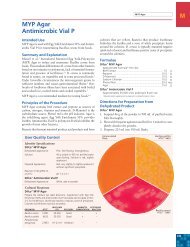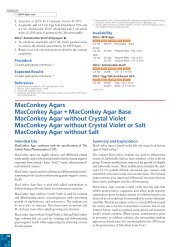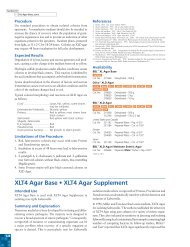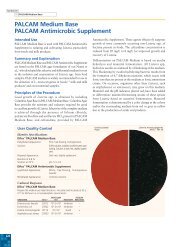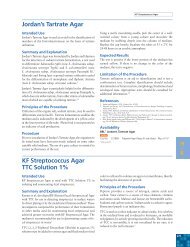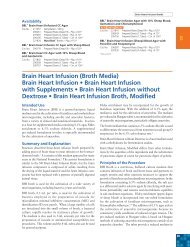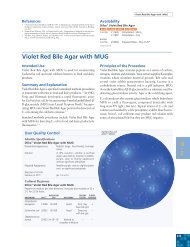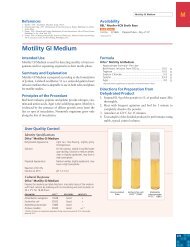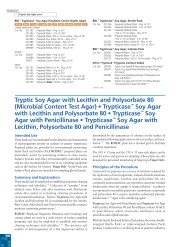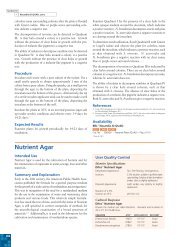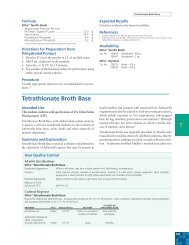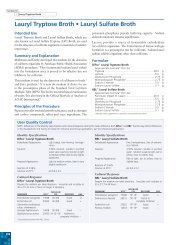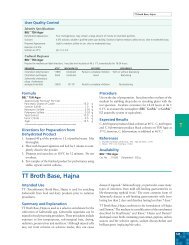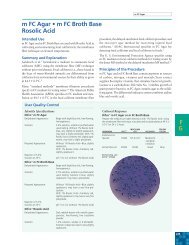MacConkey Agars with Sorbitol - BVA Scientific
MacConkey Agars with Sorbitol - BVA Scientific
MacConkey Agars with Sorbitol - BVA Scientific
Create successful ePaper yourself
Turn your PDF publications into a flip-book with our unique Google optimized e-Paper software.
Section III<br />
M <strong>MacConkey</strong> II Agar, cont.<br />
BBL <strong>MacConkey</strong> II Agar//Columbia CNA Agar <strong>with</strong> 5%<br />
Sheep Blood<br />
BS10 CMPH MCM7<br />
Cat. No. 221600 Prepared I Plate Dishes – Pkg. of 20*<br />
221601 Prepared I Plate Dishes – Ctn. of 100*<br />
BBL <strong>MacConkey</strong> II Agar//Trypticase Soy Agar <strong>with</strong> 5%<br />
Sheep Blood (TSA II)<br />
BS10 CMPH MCM7<br />
United States and Canada<br />
Cat. No. 221290 Prepared I Plate Dishes – Pkg. of 20*<br />
221291 Prepared I Plate Dishes – Ctn. of 100*<br />
Europe<br />
Cat. No. 251290 Prepared I Plate Dishes – Pkg. of 20*<br />
BBL <strong>MacConkey</strong> II Agar//Levine EMB Agar<br />
Cat. No. 295969 Prepared I Plate Dishes – Ctn. of 100*<br />
BBL <strong>MacConkey</strong> II Agar//Columbia PNA Agar <strong>with</strong> 5%<br />
Sheep Blood<br />
Cat. No. 297272 Prepared I Plate Dishes – Ctn. of 100*<br />
BBL <strong>MacConkey</strong> II Agar//Chocolate II Agar//Trypticase <br />
Soy Agar <strong>with</strong> 5% Sheep Blood (TSA II)<br />
Cat. No. 297140 Prepared Y Plate Dishes – Pkg. of 20*<br />
299580 Prepared Y Plate Dishes – Ctn. of 100*<br />
BBL <strong>MacConkey</strong> II Agar <strong>with</strong> MUG<br />
Cat. No. 221938 Prepared Plates – Pkg. of 20*<br />
BBL <strong>MacConkey</strong> II Agar <strong>with</strong> MUG//Trypticase Soy<br />
Agar <strong>with</strong> 5% Sheep Blood (TSA II)<br />
Cat. No. 221949 Prepared I Plate Dishes – Pkg. of 20*<br />
BBL <strong>MacConkey</strong> II Agar <strong>with</strong> MUG//Brucella Agar <strong>with</strong><br />
5% Horse Blood<br />
Cat. No. 298303 Prepared I Plate Dishes – Ctn. of 100*<br />
*Store at 2-8°C.<br />
<strong>MacConkey</strong> <strong>Agars</strong> <strong>with</strong> <strong>Sorbitol</strong><br />
<strong>MacConkey</strong> <strong>Sorbitol</strong> Agar • <strong>MacConkey</strong> II Agar<br />
<strong>with</strong> <strong>Sorbitol</strong> • <strong>Sorbitol</strong> <strong>MacConkey</strong> II Agar <strong>with</strong><br />
Cefixime and Tellurite<br />
Intended Use<br />
<strong>MacConkey</strong> <strong>Sorbitol</strong> Agar and <strong>MacConkey</strong> II Agar <strong>with</strong><br />
<strong>Sorbitol</strong> are selective and differential media for the detection<br />
of sorbitol-nonfermenting Escherichia coli serotype O157:H7<br />
associated <strong>with</strong> hemorrhagic colitis. These media are also<br />
referred to as “<strong>Sorbitol</strong> <strong>MacConkey</strong> Agar.”<br />
<strong>Sorbitol</strong> <strong>MacConkey</strong> II Agar <strong>with</strong> Cefixime and Tellurite<br />
(SMAC-CT) is a more selective and differential medium<br />
designed to inhibit Proteus mirabilis, non-O157 E. coli strains<br />
and other sorbitol-nonfermenting strains.<br />
Summary and Explanation<br />
Escherichia coli serotype O157:H7 is a human pathogen associated<br />
<strong>with</strong> hemorrhagic colitis that results from the action<br />
of a shiga-like toxin (SLT). 1 On standard <strong>MacConkey</strong> Agar<br />
containing lactose, this strain is indistinguishable from other<br />
lactose-fermenting E. coli. Unlike most E. coli strains, E. coli<br />
O157:H7 ferments sorbitol slowly or not at all. Therefore, the<br />
efficacy of <strong>MacConkey</strong> Agar containing sorbitol instead of<br />
lactose as a differential medium for the detection of E. coli<br />
O157:H7 in stool cultures was determined. Field trial results<br />
showed that the growth of E. coli O157:H7 on <strong>MacConkey</strong> Agar<br />
<strong>with</strong> <strong>Sorbitol</strong> was heavy and occurred in almost pure culture as<br />
colorless sorbitol-nonfermenting colonies. Most organisms<br />
of the fecal flora ferment sorbitol and appear pink on this<br />
medium. <strong>MacConkey</strong> Agar <strong>with</strong> <strong>Sorbitol</strong>, therefore, permits ready<br />
recognition of E. coli O157:H7 in stool cultures. 1-3<br />
The addition of cefixime and tellurite significantly reduces the<br />
number of sorbitol nonfermenters that need to be screened<br />
during the attempted isolation of E. coli O157:H7. 4,5<br />
Principles of the Procedure<br />
<strong>MacConkey</strong> <strong>Sorbitol</strong> Agar and <strong>MacConkey</strong> II Agar <strong>with</strong><br />
<strong>Sorbitol</strong>, modified <strong>MacConkey</strong> agars using sorbitol instead of<br />
lactose, are only slightly selective, since the concentration of<br />
bile salts, which inhibits gram-positive microorganisms, is<br />
low in comparison <strong>with</strong> other enteric plating media. Crystal<br />
violet also is included in the medium to inhibit the growth<br />
of gram-positive bacteria, especially enterococci and staphylococci.<br />
<strong>MacConkey</strong> II Agar <strong>with</strong> <strong>Sorbitol</strong> is also formulated<br />
to reduce swarming of Proteus species.<br />
<strong>MacConkey</strong> II Agar <strong>with</strong> <strong>Sorbitol</strong><br />
Escherichia coli O157:H7<br />
ATCC 35150<br />
Escherichia coli<br />
ATCC 25922<br />
340
<strong>MacConkey</strong> <strong>Sorbitol</strong> Agar, cont.<br />
User Quality Control<br />
NOTE: Differences in the Identity Specifications and Cultural Response testing for media offered as both Difco and BBL brands may reflect differences<br />
in the development and testing of media for industrial and clinical applications, per the referenced publications.<br />
M<br />
Identity Specifications<br />
Difco <strong>MacConkey</strong> <strong>Sorbitol</strong> Agar<br />
Dehydrated Appearance: Pinkish beige, free-flowing, homogeneous.<br />
Solution:<br />
5.0% solution, soluble in purified water<br />
upon boiling. Solution is reddish-purple,<br />
very slightly to slightly opalescent.<br />
Prepared Appearance: Reddish-purple, slightly opalescent.<br />
Reaction of 5.0%<br />
Solution at 25°C: pH 7.1 ± 0.2<br />
Cultural Response<br />
Difco <strong>MacConkey</strong> <strong>Sorbitol</strong> Agar<br />
Prepare the medium per label directions. Inoculate and incubate at<br />
35 ± 2°C for 18-24 hours.<br />
INOCULUM COLONY BILE<br />
ORGANISM ATCC CFU RECOVERY COLOR PPT.<br />
Enterococcus<br />
faecalis 29212 10 3 -2×10 3 Marked to – –<br />
complete<br />
inhibition<br />
Escherichia coli 25922 10 2 -10 3 Good Pink-red +<br />
Escherichia coli<br />
O157:H7 35150 10 2 -10 3 Good Colorless –<br />
Differentiation of enteric microorganisms is achieved by the<br />
combination of sorbitol and the neutral red indicator. Colorless<br />
or pink to red colonies are produced depending upon the ability<br />
of the isolate to ferment the carbohydrate sorbitol.<br />
SMAC-CT is modified <strong>MacConkey</strong> II Agar using sorbitol instead<br />
of lactose and <strong>with</strong> cefixime (0.05 mg/L) and potassium tellurite<br />
(2.5 mg/L) added. Cefixime inhibits Proteus spp. and tellurite<br />
inhibits non-O157 E. coli and other organisms, thus improving<br />
the selectivity of SMAC-CT for E. coli O157:H7.<br />
Formulae<br />
Difco <strong>MacConkey</strong> <strong>Sorbitol</strong> Agar<br />
Approximate Formula* Per Liter<br />
Peptone ................................................................... 15.5 g<br />
Proteose Peptone ....................................................... 3.0 g<br />
D-<strong>Sorbitol</strong> ................................................................. 10.0 g<br />
Bile Salts ..................................................................... 1.5 g<br />
Sodium Chloride ........................................................ 5.0 g<br />
Agar ......................................................................... 15.0 g<br />
Neutral Red ................................................................ 0.03 g<br />
Crystal Violet .............................................................. 1.0 mg<br />
BBL <strong>MacConkey</strong> II Agar <strong>with</strong> <strong>Sorbitol</strong><br />
Approximate Formula* Per Liter<br />
Pancreatic Digest of Gelatin ..................................... 17.0 g<br />
Pancreatic Digest of Casein ........................................ 1.5 g<br />
Peptic Digest of Animal Tissue ................................... 1.5 g<br />
D-<strong>Sorbitol</strong> ................................................................. 10.0 g<br />
Bile Salts ..................................................................... 1.5 g<br />
Sodium Chloride ........................................................ 5.0 g<br />
Agar ......................................................................... 13.5 g<br />
Neutral Red ................................................................ 0.03 g<br />
Crystal Violet .............................................................. 1.0 mg<br />
*Adjusted and/or supplemented as required to meet performance criteria.<br />
Identity Specifications<br />
BBL <strong>MacConkey</strong> II Agar <strong>with</strong> <strong>Sorbitol</strong><br />
Dehydrated Appearance: Fine, homogeneous, may contain dark<br />
particles.<br />
Solution:<br />
5.0% solution, soluble in purified water<br />
upon boiling. Solution is medium to dark,<br />
rose to brown-rose, <strong>with</strong> or <strong>with</strong>out a<br />
trace orange tint, clear to slightly hazy.<br />
Prepared Appearance: Medium to dark, rose to brown-rose,<br />
<strong>with</strong> or <strong>with</strong>out a trace orange tint,<br />
clear to slightly hazy.<br />
Reaction of 5.0%<br />
Solution at 25°C: pH 7.1 ± 0.2<br />
Cultural Response<br />
BBL <strong>MacConkey</strong> II Agar <strong>with</strong> <strong>Sorbitol</strong><br />
Prepare the medium per label directions. Inoculate and incubate at<br />
35 ± 2°C for 18-24 hours (42-48 hours for E. coli ATCC 25922).<br />
INOCULUM COLONY BILE<br />
ORGANISM ATCC CFU RECOVERY COLOR PPT.<br />
Escherichia coli 25922 10 3 -10 4 Good Pink to red +<br />
to rose-red<br />
Escherichia coli<br />
O157:H7 35150 10 3 -10 4 Good Colorless –<br />
Proteus mirabilis 12453 10 3 -10 4 Good Colorless –<br />
Directions for Preparation from<br />
Dehydrated Product<br />
1. Suspend 50 g of the powder in 1 L of purified water. Mix<br />
thoroughly.<br />
2. Heat <strong>with</strong> frequent agitation and boil for 1 minute to completely<br />
dissolve the powder.<br />
3. Autoclave at 121°C for 15 minutes.<br />
4. Test samples of the finished product for performance using<br />
stable, typical control cultures.<br />
Procedure<br />
Prepare plated medium from tubed agar deeps by liquefying<br />
the medium in boiling water, cooling to 45-50°C and pouring<br />
into sterile Petri dishes.<br />
Use standard procedures to obtain isolated colonies from<br />
specimens. Incubate plates, protected from light, in an inverted<br />
position (agar side up) at 35 ± 2°C for 18-24 hours in an aerobic<br />
atmosphere <strong>with</strong>out additional CO 2 .<br />
Expected Results<br />
After 18-24 hours of incubation, the plates should show isolated<br />
colonies in streaked areas and confluent growth in areas of<br />
heavy inoculation.<br />
<strong>Sorbitol</strong> fermenters produce pink to red colonies, some surrounded<br />
by zones of precipitated bile, while sorbitol nonfermenters<br />
produce colorless colonies.<br />
Most fecal flora will be partially to completely inhibited on<br />
SMAC-CT.<br />
341
Section III<br />
M <strong>MacConkey</strong> <strong>Sorbitol</strong> Agar, cont.<br />
Gram staining, biochemical tests and serological procedures<br />
should be performed to confirm findings.<br />
Limitations of the Procedure<br />
1. It has been reported that some Enterobacteriaceae and<br />
Pseudomonas aeruginosa are inhibited on <strong>MacConkey</strong> Agar<br />
when incubated in a CO 2 -enriched atmosphere. 6<br />
2. Prolonged incubation of the culture may result in colonies<br />
of E. coli serotype O157:H7 losing their characteristic<br />
colorless appearance. There are additional species of<br />
facultatively anaerobic gram-negative rods that do not<br />
ferment sorbitol.<br />
3. The color of sorbitol-positive colonies can fade, making<br />
them hard to distinguish from sorbitol-negative colonies. 7<br />
References<br />
1. March and Ratnam. 1986. J. Clin. Microbiol. 23:869.<br />
2. Centers for Disease Control. 1991. Morbid. Mortal. Weekly Rep. 40:265.<br />
3. Bopp, Brenner, Wells and Stockbine. 1999. In Murray, Baron, Pfaller, Tenover and Yolken (ed.),<br />
Manual of clinical microbiology, 7th ed. American Society for Microbiology, Washington, D.C.<br />
4. Zadik, Chapman and Siddons. 1993. J. Med. Microbiol. 39:155.<br />
5. Sanderson, Gay, Hancock, Gay, Fox and Besser. 1995. J. Clin. Microbiol. 33:2616.<br />
6. Mazura-Reetz, Neblett and Galperin. 1979. Abstr. C 179, p. 339. Abstr. Annu. Meet. Am. Soc.<br />
Microbiol. 1979.<br />
7. Adams. 1991. Clin. Lab. Sci. 4:19.<br />
Availability<br />
Difco <strong>MacConkey</strong> <strong>Sorbitol</strong> Agar<br />
BAM BS10 CCAM CMPH COMPF ISO MCM7 SMWW USDA<br />
Cat. No. 279100 Dehydrated – 500 g<br />
BBL <strong>MacConkey</strong> II Agar <strong>with</strong> <strong>Sorbitol</strong><br />
BAM BS10 CCAM CMPH COMPF ISO MCM7 SMWW USDA<br />
Cat. No. 299769 Dehydrated – 500 g<br />
United States and Canada<br />
Cat. No. 297684 Prepared Deeps (Pour Tubes) – Pkg. of 10<br />
297953 Prepared Plates – Pkg. of 10*<br />
298519 Prepared Plates – Ctn. of 100*<br />
Europe<br />
Cat. No. 254455 Prepared Plates – Pkg. of 20*<br />
Japan<br />
Cat. No. 251147 Prepared Plates – Pkg. of 20*<br />
251767 Prepared Plates – Ctn. of 100*<br />
BBL <strong>MacConkey</strong> II Agar <strong>with</strong> <strong>Sorbitol</strong>//SS Agar<br />
Japan<br />
Cat. No. 251163 Prepared I Plate Dishes – Ctn. of 100*<br />
BBL <strong>Sorbitol</strong> <strong>MacConkey</strong> II Agar <strong>with</strong> Cefixime and<br />
Tellurite<br />
United States and Canada<br />
Cat. No. 222226 Prepared Plates – Pkg. of 10*<br />
222227 Prepared Plates – Ctn. of 100*<br />
Europe<br />
Cat. No. 257019 Prepared Plates – Pkg. of 20*<br />
*Store at 2-8°C.<br />
<strong>MacConkey</strong> Broth<br />
Intended Use<br />
<strong>MacConkey</strong> Broth is used for cultivating gram-negative, lactosefermenting<br />
bacilli in water and foods as a presumptive test for<br />
coliform organisms.<br />
Summary and Explanation<br />
<strong>MacConkey</strong> Broth is a modification of the original bile salt broth<br />
recommended by <strong>MacConkey</strong> 1 that contained 0.5% sodium<br />
taurocholate and litmus as an indicator. In later publications, 2,3<br />
User Quality Control<br />
Identity Specifications<br />
Difco <strong>MacConkey</strong> Broth<br />
Dehydrated Appearance: Light beige, free-flowing, homogeneous.<br />
Solution:<br />
3.5% solution, soluble in purified water.<br />
Solution is purple, clear.<br />
Prepared Appearance: Purple, clear.<br />
Reaction of 3.5%<br />
Solution at 25°C: pH 7.3 ± 0.1<br />
Cultural Response<br />
Difco <strong>MacConkey</strong> Broth<br />
Prepare the medium per label directions. Inoculate and incubate at 35 ±<br />
2°C for 18-24 hours.<br />
INOCULUM<br />
ORGANISM ATCC CFU RECOVERY ACID GAS<br />
Enterococcus faecalis 29212 10 3 -2×10 3 Marked to – –<br />
complete inhibition<br />
Escherichia coli 25922 10 2 -10 3 Good + +<br />
Salmonella choleraesuis<br />
subsp. choleraesuis<br />
serotype Choleraesuis<br />
var. kunzendorf 12011 10 2 -10 3 Good – –<br />
Key: + = positive, yellow for acid, gas<br />
– = negative, no change for acid, no gas<br />
Uninoculated<br />
Tube<br />
Escherichia coli<br />
ATCC 25922<br />
342



